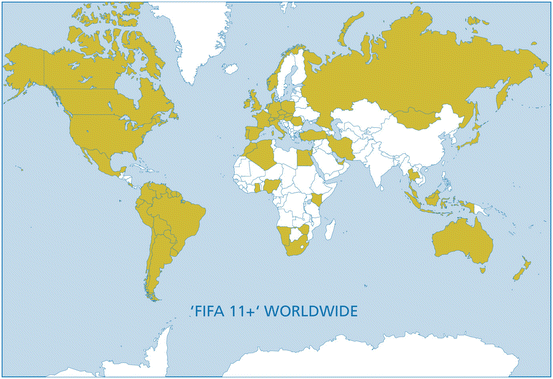Fig. 16.1
FIFA 11+ implementation guideline. “Eleven steps to implement FIFA 11+”
The national Football Associations of Spain, Japan, Italy, Brazil and Germany integrated “FIFA 11+” in their coaching curriculum or in their physical training/education curriculum. Thus, the world football champions took the lead and acted as role models, and other MAs (Costa Rica, Hong Kong, Netherlands, Denmark, Poland, Hungary, Australia, England, Thailand, and Singapore) followed. Up to now about 6,000 coaches from more than 70 countries have been instructed on how to implement the “FIFA 11+” (Bizzini et al. 2013b) (Fig. 16.2). Even if this represents just about 25 % of FIFA’s MAs and a much lower percentage of all football coaches, it is an important step for the worldwide dissemination of the programme. F-MARC supports the MAs in the preparation of the educational material in the local language, and the workshops for the first group of instructors to initiate the cascade training.


Fig. 16.2
FIFA 11+ worldwide. The countries in the yellow are the ones whose coaches attended a FIFA 11+ instructor course (2008–2013)
See ESM 2.
16.5 Lessons Learned
The F-MARC team has gained experience during the years of dissemination of the injury prevention programmes. It has been found that understanding the coach’s character and highlighting the importance of the programme to the coach is especially important. By preventing injuries and therefore reducing the number of injured players, the coach will have more players available for his/her ideal team. Therefore, it is not only information and education about the role of injury prevention which is important, but moreover to speak the same language as the coach. One of keys while conducting a course is “proposing” rather than “imposing” “FIFA 11+”. The dialogue on the pitch with coaches is often more important than the distributed materials, thus allowing for friendly discussion and practical work with the preventive programme. Therefore, the choice of the instructors is crucial and F-MARC’s best experiences have been with sports physiotherapists or athletic trainers who have an active involvement in football, because they already “live and speak the football language”. Additionally, cooperation with famous players and coaches acting as “FIFA 11+” ambassadors (see teaser on https://vimeo.com/45562029 and www.f-marc.com/11plus) has helped significantly in the communication with coaches. “FIFA 11+” has also been presented to the delegates of all MAs at the last two FIFA Medical Conferences (Zürich 2009; Budapest 2012). After initial enthusiasm from the interested MAs, F-MARC has experienced a wide range of dedication and compliance from those MAs to the proposed “FIFA 11+” implementation guidelines. At the MA level, it has to be acknowledged that highly motivated people are needed, in order to successfully plan, realise, and constantly monitor a countrywide implementation.
16.6 Conclusions and Future Directions
The two countrywide campaigns in Switzerland and New Zealand represent successful examples of injury prevention in amateur football (Dick et al. 2009; Junge et al. 2011). Gianotti and Hume (2007) introduced pre- and post-implementation cost outcome formulae to provide information regarding the success of a prevention programme. These data provide a return on investment for each dollar invested in the programme and subsequent cost-savings. Since the SoccerSmart Programme (including the “The 11” programme) was introduced in New Zealand in 2004, the Accident Compensation Corporation (ACC) has invested 650,000 NZ Dollars. Up to June 2011, ACC has saved 5,331,000 NZ Dollars: the return of investment has risen to 8.20 for each invested Dollar (personal communication of Dr. S. Gianotti, ACC, New Zealand). These data, together with the published results of the countrywide implementation in Switzerland, reinforce the hypothesis outlined by F-MARC back in 1994: prevention measures or programmes can not only reduce the incidence of football injuries, but have the potential to save billions of dollars in health-related costs worldwide (Dvorak 2009).
In the next years FIFA and F-MARC will continue the worldwide dissemination of the “FIFA 11+”, with particular attention to seeking the best possible cooperation with the MAs adopting the “FIFA 11+” injury prevention programme.
References
Agel J, Evans TA, Dick R et al (2007) Descriptive epidemiology of collegiate men’s soccer injuries: National Collegiate Athletic Association Injury Surveillance System, 1988–1989 through 2002–2003. J Athl Train 42(2):270–277. Epub 2007/08/22PubMedCentralPubMed
Bizzini M, Junge A, Dvorak J (2013b) Implementation of the FIFA 11+ football warm up program: how to approach and convince the Football associations to invest in prevention. Br J Sports Med 47(12):803–806. Epub 2013/06/27PubMedCentralPubMedCrossRef
Brito J, Figueiredo P, Fernandes L et al (2010) Isokinetic strength effects of FIFA’s “The 11+” injury prevention training programme. Isokinet Exerc Sci 18:211–215
Daneshjoo A, Mokhtar AH, Rahnama N et al (2012a) The effects of comprehensive warm-up programs on proprioception, static and dynamic balance on male soccer players. PLoS One 7(12):e51568. Epub 2012/12/20PubMedCentralPubMedCrossRef
Daneshjoo A, Mokhtar AH, Rahnama N et al (2012b) The effects of injury preventive warm-up programs on knee strength ratio in young male professional soccer players. PLoS One 7(12):e50979. Epub 2012/12/12PubMedCentralPubMedCrossRef
Dick R, Putukian M, Agel J et al (2007) Descriptive epidemiology of collegiate women’s soccer injuries: National Collegiate Athletic Association Injury Surveillance System, 1988–1989 through 2002–2003. J Athl Train 42(2):278–285. Epub 2007/08/22PubMedCentralPubMed
Dick R, Gaulet C, Gianotti S (2009) Implementing large-scale injury prevention programs. In: Bahr R, Engebretsen L (eds) Injury prevention. Wiley-Blackwell, Chichester
Stay updated, free articles. Join our Telegram channel

Full access? Get Clinical Tree








